Who earned what?
At the back end of the seventeenth century a man named Gregory King took it upon himself to find out how well-off the people of England actually were. He did it as a hobby, following his promotion from Rouge Dragon Poursuivant in the College of Arms to Lancaster Herald. In his day job he was a commissioner in charge of a new tax on marriages, births and burials.
King produced a table breaking down the population by occupation and income for the year 1688. He was very clear as to who was a Ruler and who was not. In his world, a third of the citizens were Chiefs, and two-thirds Indians.
| RULERS | Number of Persons | Number of Families | Family Income (£) | |
| Aristocracy | Temporal Lords | 6,400 | 160 | 3,200 |
| Spiritual Lords | 520 | 26 | 1,300 | |
| Gentry | Baronets | 12,800 | 800 | 800 |
| Knights | 7,800 | 600 | 650 | |
| Esquires | 30,000 | 3,000 | 450 | |
| Gentlemen | 96,000 | 12,000 | 280 | |
| Citizens, Burgesses & Yeomen | Government Office Holders | 70,000 | 10,000 | 180 |
| Merchants & Traders by Sea | 64,000 | 10,000 | 238 | |
| Lawyers | 70,000 | 10,000 | 154 | |
| Clergymen | 52,000 | 10,000 | 54 | |
| Yeomen | 280,000 | 40,000 | 91 | |
| Husbandmen | 660,000 | 120,000 | 55 | |
| Tenant Farmers | 750,000 | 150,000 | 43 | |
| Persons in Liberal Arts & Sciences | 75,000 | 15,000 | 60 | |
| Shopkeepers & Tradesmen | 225,000 | 50,000 | 45 | |
| Artisans & Handicrafts | 240,000 | 60,000 | 38 | |
| Naval Officers | 20,000 | 5,000 | 80 | |
| Military Officers | 16,000 | 4,000 | 60 | |
| Subtotal | 2,675,520 | 500,586 | 69 | |
| ~ | ||||
| RULED | ||||
| Common Seamen | 150,000 | 50,000 | 20 | |
| Labourers & Outservants | 1,275,000 | 364,000 | 15 | |
| Cottagers & Paupers | 1,300,000 | 400,000 | 7 | |
| Common Soldiers | 70,000 | 35,000 | 14 | |
| Vagrants, Thieves, Gypsies | 30,000 | ... | ... | |
| Subtotal | 2,825,000 | 849,000 | 11 | |
| Totals - All England | 5,500,520 | 1,349,586 | 32 | |
This is such an interesting and informative piece of work that it's tempting to ramble on for several thousand words exploring what it says about society at that time. But instead I'll make just one observation. The yeomen, husbandmen and tenant farmers (the people who actually ran the farms) between them made up 31% of the population, whilst their labourers accounted for another 47%. Three people out of every four worked on the land.
What did people eat?
Gregory King also looked at what kinds of food were eaten by three important nations - England, France, and Holland. His figures this time are for 1695, and he lists the average spending per head of the population in pounds (£) over the year.
| Consumable | England | France | Holland |
| Bread + other food made from grain | 0.79 | 0.75 | 0.63 |
| Beef, mutton, veal, venison, conies | 0.61 | 0.39 | 0.36 |
| Butter, cheese, milk | 0.42 | 0.30 | 0.27 |
| Fish, fowl, eggs | 0.31 | 0.27 | 0.49 |
| Fruit + vegetables | 0.22 | 0.25 | 0.18 |
| Salt, oil, pickles, confectionery | 0.20 | 0.21 | 0.13 |
| Beer + ale | 1.06 | 0.01 | 0.54 |
| Wine, brandy, spirits | 0.24 | 0.64 | 0.18 |
| Totals | £3.85 | £2.82 | £2.78 |
| Population (millions) | 5.45 | 13.5 | 2.24 |
So the English drank a vast amount of beer, whilst the French preferred wine, and citizens of all three countries spent about the same amount on bread. That comes as no surprise. What is surprising is to find that the English were eating so much more meat than the others. ('Conies' are rabbits, by the way.) And the English had more to spend, too. King says that in 1695 they spent, per head, nearly 40% more on food than their neighbours did. If the English were better fed, did they have larger families? Or was it just that food cost more in England?
Several historians comment that the English were great meat-eaters. G.M. Trevelyan's judgement was that
The staple diet was bread, or rather bread, beer and usually meat. Vegetables and fruit played a small, and meat a very large, part in the English meal of that date ...
Gregory King reckoned that half the population ate meat daily, and that most of the other half ate meat at least twice a week. If that's true, the Englishmen who did eat meat (and my guess is it was mainly the Rulers, such as Parson Woodforde, for example) must have eaten an awful lot of it. Twenty years after King, even Daniel Defoe - who was, let's not forget, a journalist - felt he had to point out that
English labouring people eat and drink, especially the latter, three times as much in value as any sort of foreigners of the same dimensions in the world.
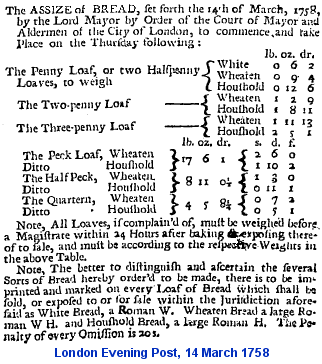
But bread was the staple food, and the cost of bread was a major item in most people's weekly budget. Government had been aware of this since at least the 12th century. The legal weight of a penny loaf had long been fixed by local Assizes to reflect the local cost of wheat. In 1757 Parliament tried to get citizens to eat less high-quality bread by passing an Act that created a new category of loaf: 'Household Bread'. From now on, said the Act, half of all bread sold must be Household Bread, which will (by law) have a higher proportion of coarse grain mixed back into the flour. Unfortunately, people didn't like it. They preferred bread made from proper wheat, even though it was more expensive.
The early 1790s brought a succession of bad harvests, and the harvest of 1795 was disastrous. The price of wheat almost doubled. Food riots broke out up and down the country. Then both Holland and Spain joined France in the war on England, whilst at home the Prince of Wales married Caroline of Brunswick (and since the Prince's personal debts then amounted to over half a million pounds, the government felt obliged to grant him an extra £65,000 a year to help pay them off).
The shortage of wheat had become an urgent problem. An angry mob attacked the King's carriage when he was on his way to open Parliament, and so the gentlemen in the House of Commons suddenly found time to debate the matter again. They decided that in future more lower-quality bread should be produced, and that other grains should be used too. Barley, for example, was 40% cheaper than wheat. When Fox spoke in the debate, he urged the gentlemen
... not to judge from any experiment made with respect to themselves. I have myself tasted bread of different sorts, I have found it highly pleasant, and I have no doubt it is exceedingly wholesome. But it ought to be recollected how very small a part the article of bread forms of the provisions consumed by the more opulent classes of the community. To the poor it constitutes, the chief, if not the sole article of subsistence.
So even the Rulers were aware that the Ruled ate much more bread than meat. For their part, the less well-off (in the south of England, anyway) were indignant that they were expected to eat bread made from animal fodder such as rye, barley or oats. Elsewhere in the country people were quite happy to eat other grains.
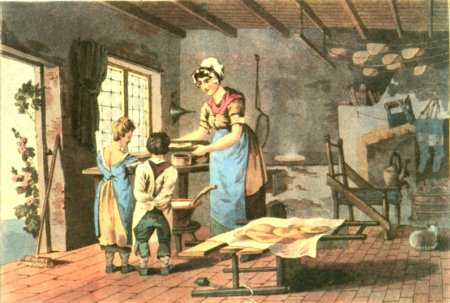
In Yorkshire, it seems that the poor people ate a lot of oatmeal, which was cheaper than wheat and easier to grow. In fact, the town of Otley is supposed to have been named (from Oatley, or Oat-field) for the quantity of oats grown around there. This picture of a woman making oatcakes dates from the early 19th century, by which time her cottage had two storeys and a brick floor. A hundred years earlier, living conditions for the poor were rather more primitive.
The oatcake (said Walker in 1814, in his Costumes of Yorkshire) ...
... is almost exclusively made in the West Riding of Yorkshire, and constitutes the principal food of the labouring classes in that district. It is a very thin cake, composed of oatmeal and water only, and by no means unpalatable, particularly while it is new. The mixture is made of a proper consistence in a large bowl, and measured out for each cake by a ladle. As the price of an oat cake is invariably one penny, the size of the ladle of course depends on the rate of meal in the market. The process of making these cakes will readily be understood by referring to the Plate. Some dry meal is sifted upon a flat board, and a ladle-full of the mixture poured over it. The cake is formed and brought to a proper size and thickness by a horizontal movement of the board, as here represented. It is then laid upon what is termed the Backstone, or hot hearth, to bake, which does not require many seconds of time, and afterwards placed upon a cloth to cool. An inverted chair, as seen in the plate, frequently serves this purpose. The cakes are then hung upon a frame, called a 'Bread Creel', suspended from the ceiling of almost every cottage in the district. The people in the neighbourhood of Huddersfield are fond of what they term 'Browiss', which is oat cake sopped in broth or gravy.
Trevelyan's statement that 'vegetables played a small part in the English meal of that date' makes me uneasy, too. Certainly Parson Woodforde and his friends ate a lot of meat, but then they could afford to. Gregory King's Table shows that the English spent more on meat, not necessarily that they ate more meat. And he was living in an age when most people had a small plot of land and worked in their spare time to grow vegetables for their own consumption. I wonder how King valued this work. I suspect that since he couldn't measure it, he simply ignored it.
A cottage garden could be very productive (though I'd guess it usually wasn't). It was estimated that an area of one-eighth of an acre - then known as 20 rods - could feed a family of five. As well as a pig, fowls and ducks, there would be space for
1 rod onions and leeks, ½ rod carrots, ½ rod windsor beans, 1 rod parsnips, 3 rods cabbages,
4 rods early potatoes, 4 rods Prussian potatoes, 6 rods Devonshire potatoes
with fruit trees trained against the walls of the house. Another plan for the same space predicted that it should yield every year 30 bushels of potatoes, 5 of parsnips, 5 of carrots, 5 of beetroot, 5 of onions, and 300 cabbages. That should keep the wolf from the door, as my mother used to say (unless the wolf was still hungry after it had eaten all the livestock).
As to how people could afford their food, Trevelyan quotes a Yorkshire squire writing in 1701.
The wages of a good husbandman in the parts around Barnsley and Wortley I find to be no more than £3 a year, and Sir Godfrey gives his keeper but £3 14s., and his bailiff £4, so that we are worse served for high wages. About Wortley, all the husbandmen are up every morning with their beasts at three o'clock and in our house they lie abed till near seven.
He's talking about farm workers' wages, not their total income. Food and lodging would have been provided in addition. King's figures for 1688 say that the average family annual income for 'Labourers and Outservants' was £15 a year. Tenant farmers were making over £40 a year, and this at a time when chickens could be bought in the West Riding for two pence each (there were 240 pennies in a pound). In today's money, that would put the price of a chicken at somewhere around £3, which is surprisingly close to what a chicken actually does cost today. And I thought we were living in an age of cheap food.
The price of bread
If people were living mainly on bread, what did it cost? A man called William Playfair took the trouble (in 1821) to plot the price of wheat and the wages of 'a good mechanic' for the previous 250 years or so.
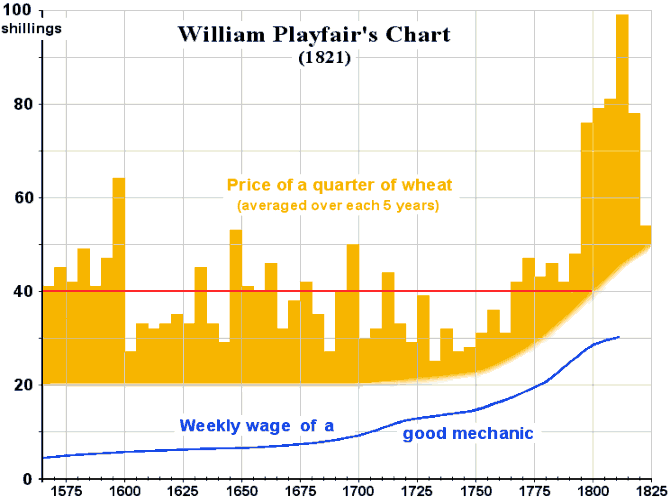
The graph is not really helpful as it stands. Playfair used the commonly-accepted measure of a 'quarter' of wheat, which I had to look up (though everyone understood at the time) to discover it means 8 bushels. A bushel is (apparently) 8 gallons. Clear so far? So now all I need is find out how much a bushel of wheat weighs, and I can do the sums.
According to several Internet sites, a bushel of wheat is equivalent to 60 lb. It follows that a 'quarter' of wheat weighs 480 lb, which is just under a quarter of a ton. Maybe that's what the word meant. I'm going to assume that the mechanic would have bought his bread in 2 lb. loaves, so the next question is, how much of that 2 lb. was wheat?
Ed, who knows about these things, tells me that his loaves are about 60% wheat (though Mrs. Beeton's were about 75%). So 480 lb. of wheat would make (say) 350 loaves, each weighing 2 lb. Interestingly, this implies that a quarter of wheat provides bread for one man for a year.
It seems that the price of a quarter of wheat began to rise steeply in about 1750. But at this time agriculture was becoming steadily more productive, so shouldn't the price of wheat have fallen rather than risen? After all, if the cost of a loaf of bread went up every year, wouldn't people have eaten less of it? I would have expected that fewer of them would have felt rich enough to marry. In fact, some people might even have starved to death, and the population would have fallen. But it didn't. Why not?
The key question is, what did a loaf of bread actually cost? The average price of a quarter of wheat was 40 shillings for over two hundred years, and a quarter of wheat can be turned into (let's say) 350 loaves. It follows that the wheat in a 2 lb. loaf cost about 1.4 pence (remember there were 240 pennies in a pound in those days). Add in the cost of milling and baking, plus some profit, and the loaf might sell for perhaps 2 pence. So assuming the mechanic ate a loaf of bread a day (like some teenagers I've known) and had no family to support, his daily bread would have cost him something over a shilling a week. If he was earning ten shillings a week, that's around 15% of his income.
And how did this vary over Playfair's 250 year timescale? What proportion of the mechanic's wages did he spend on bread? It's easy enough to calculate.
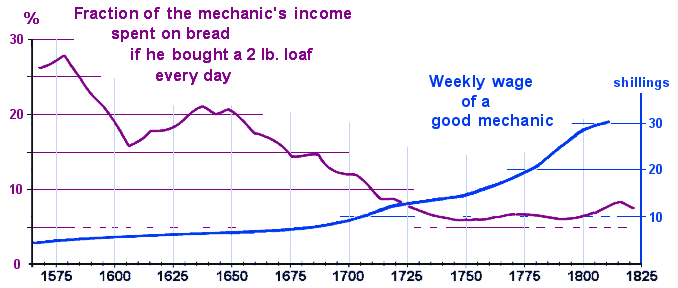
It's clear from this that the real price of bread went down almost every year since Elizabeth's fleet defeated the first great Spanish armada in 1588. It rose briefly whilst James I and his son Charles I were in charge, loftily insisting on their Divine Right to Do Whatever they Felt Like, but from the Civil War onwards bread grew relatively cheaper and cheaper. And as a result, more and more people chose to get married and have babies.
Presented like this, Playfair's data tells a very different story. No wonder so many people have learned to distrust 'statistics', and 'graphs'. The impression a graph gives depends on the question it was created to answer. Asking the right question is crucial.
So let's ask another question: how important was the harvest? If the summer was cold and rainy, and the harvest was a poor one, how much difference did it make to peoples' day-to-day lives? Presumably the price of wheat would have risen if it was scarce, so more wheat would have been imported, but a loaf of bread would still have been more expensive. How much more?
I found some data on the average prices London consumers had to pay for a quartern loaf of bread in the eighteenth century. (A quartern loaf was made from flour weighing one quarter of a stone - that is, 3½ lb. - so the final loaf weighed a little over 4 lb.) If a 2 lb. loaf should have cost about 3d., a 4 lb. loaf should have sold for about 6d., as Parson Woodforde says it did. The graph below shows what a loaf actually cost.
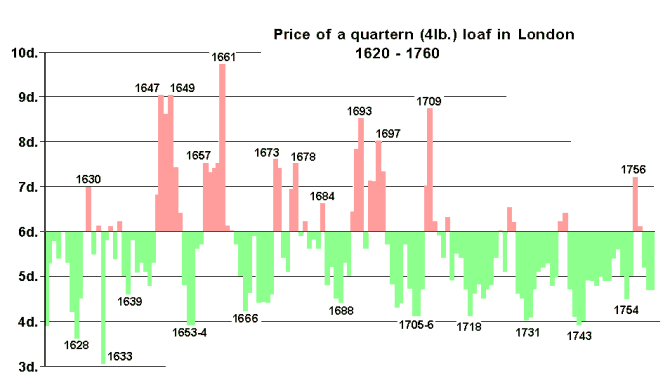
The variations between one year and another were dramatic, to say the least. A loaf that sold for 4d. in 1706 cost more than twice as much just three years later. And by then the worst fluctuations had begun to disappear, probably because grain was being imported as it was needed. The price of bread did tend to fall slowly throughout the century - the graph shows solid areas of green from 1700 onwards - but it still lurched randomly up and down by 10% or more between one year and the next. The harvest did matter. When people sang "Praise the Lord for harvest home" they really meant it.
And it wasn't just the consumers who thanked God for a good harvest. The farmers' incomes depended on selling their grain. It's not surprising that governments saw it as their job to maintain the price of bread at a reasonably high level. For example,
... under the Corn Bounty Act of 1688, the merchant who sent grain abroad received a present from the state of 5s. a quarter for wheat ...The aim was to keep the price of wheat in England at or above 48s. a quarter, or, in the words of Adam Smith, 'to raise the money price of corn as high as possible, and thereby to occasion, as much as possible, a constant dearth in the home market'.
An export bounty was supposed to increase the amount of corn grown, and so (eventually) reduce its price in the home market. Adam Smith also pointed out the downside: if government subsidises the export of corn, the amount available for home consumption is less, so its price is higher. Consumers are penalised twice - the home price is higher than it need be, and consumers are forced to pay the subsidy which makes it so high - but then, nobody seemed to care much about the people who actually ate all this bread.
Sources
- Illustrated English social history, Trevelyan, 1944;
- Cottage gardens: The Gardener's Magazine - Loudon, 1826 onwards, quoted in The Cottage Garden - Scott-James, 1981;
- Bushels: the University of North Carolina website
- Wealth of Nations, Adam Smith
- An economic history of England, Ashton, 1955
- 4lb loaf prices are from Harvest fluctuations and English economic history 1620-1759, Hoskins, Ag.Hist.Rev., 1967(?).
